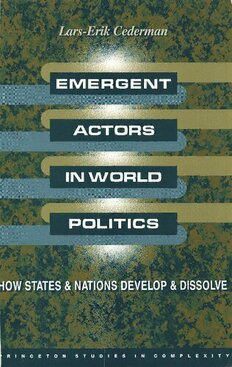
Emergent Actors in World Politics: How States and Nations Develop and Dissolve PDF
Preview Emergent Actors in World Politics: How States and Nations Develop and Dissolve
1 Lars-ErikCederman % ^ . ■c'. hlOW STATES & NAAs DEVELOP & DISSOLVE v-i' jt 3 Jl R I N C E T O N STUD I ES N COMP LEX I TY EMERGENT ACTORS IN WORLD POLITICS PRINCETON STUDIES IN COMPLEXITY Editors n Philip W. Anderson (Princeton University) Joshua M. Epstein (The Brookings Institution) Duncan K. Foley (Barnard College) Simon A. Levin (Princeton University) Gottfried Mayer-Kress (University of Illinois) Forthcoming Titles Robert Axelrod, The Complexity of Cooperation: Agent-Based Models of Competition and Collaboration Scott Camazine, Jean-Louis Deneubourg, Nigel Franks, and Thomas Seeley, Building Biological Superstructures: Models of Self-Organization James P. Crutchfield and James E. Hanson, Computational Mechanics of Cellular Processes Ralf W. Wittenberg, Models of Self-Organization in Biological Development EMERGENT ACTORS IN WORLD POLITICS HOW STATES AND NATIONS DEVELOP AND DISSOLVE Lars-Erik Cederman PRINCETON UNIVERSITY PRESS PRINCETON, NEW JERSEY Copyright © 1997 by Princeton University Press Published by Princeton University Press, 41 William Street, Princeton, New Jersey 08540 In the United Kingdom; Princeton University Press, Chichester, West Sussex All Rights Reserved Library of Congress Cataloging-in-Publication Data Cederman, Lars-Erik, 1963- Emergent actors in world politics : how states and nations develop and dissolve / Lars-Erik Cederman. P- cm. — (Princeton studies in complexity) Includes bibliographical references and index. ISBN 0-691-02149-X (cl ; alk. paper). — ISBN 0-691-02148-1 (pb : alk. paper) 1. International relations. 2. National state. 3. World politics—1989- I. Title. II. Series. JX1391.C37 1997 327.1'01—dc21 96-45562 CIP This book has been composed in Times Roman Princeton University Press books are printed on acid-free paper and meet the guidelines for permanence and durability of the Committee on Production Guidelines for Book Longevity of the Council on Library Resources Printed in the United States of America by Princeton Academic Press 2 4 6 8 10 9 7 5 3 1 2 4 6 8 10 9 7 5 3 1 (Pbk.) IN MEMORY OF MY GRANDMOTHER Marta Malmberg BORN IN 19 0 5, THE YEAR THAT THE PEACEFUL DISSOLUTION OF THE SWEDISH- NORWEGIAN UNION WAS AGREED UPON IN KARLSTAD, THE CITY OF MY CHILDHOOD Contents List of Tables IX List of Figures XI Preface Xlll Chapter 1. Introduction 3 Chapter 2. Modeling Actors in World Politics 14 Introduction 14 Defining the State and the Nation 16 From Reification to Emergence 19 An Overview of the Literature 23 Why Models Are Needed 29 Why Current Models Will Not Do the Trick 32 Conclusion 36 Chapter 3. Toward Richer Models 37 Introduction 37 The Problem of Historical Contingency 38 The Problem of Methodological Individualism and Materialism 44 The Complex Adaptive Systems Approach 49 An Introduction to the Models 69 Chapter 4. Emergent Polarity 72 Introduction 72 Power Politics and Emergent Polarity 74 A Nontechnical Overview 79 Technical Specification 81 The Impact of Predation and Defense: Hegemonic Takeoff 92 The Impact of Defensive Alliances: Regional Balancing 98 Conclusion 104 Chapter 5. Extending the Emergent Polarity Model 109 Introduction 109 Simplifying the Alliance Mechanism: Power Balancing 109 Strategic Adaptation 112 Proportional Resource Allocation 117 Two-Level Action 121 An Example of Geopolitical Overextension 126 Viii CONTENTS Chapter 6. Modeling Nationalism 136 Introduction 136 A Taxonomy of Nations and States 138 Three Types of Nationalism 141 Nationalist Mobilization and Coordination 146 Chapter 7. Nationalist Mobilization 151 Introduction 151 Modeling Political Mobilization 152 Modeling Collective Action 163 Historical Illustrations 170 Conclusion 174 Appendix 177 Chapter 8. Nationalist Coordination 184 Introduction 184 An Ecological Model of Nationality Formation 187 Technical Specification 191 Simulation Results 197 Nationalist Coordination and the Formation of Yugoslavia 201 Conclusion 210 Chapter 9. Conclusions for Theory and Policy 213 Substantive Findings 213 Closing the Metatheoretical Gap 219 Consequences for Policy 222 Bibliography 233 Index 255 Tables 3.1 A guide to the four modeling chapters 70 7.1 A comparison of three basic hypotheses 157 8.1 The fit of transcommunal identities 192
